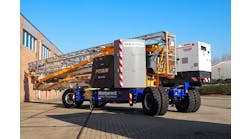Interview with Snorkel’s Cory Rosencranse: Positive Directions
Cory Rosencranse, CEO, Xtreme Manufacturing and Snorkel, talks about improvements to existing products, pros and cons of electric units, improvements in charging infrastructure, market opportunities and more.
RER: What new equipment enhancements or developments has your company come up with in the past year?
Rosencranse: Xtreme and Snorkel design groups have been busy this year working on projects from small, lightweight scissors, with our S3013Mini, S3220Mini, and S3219Plus models, which focus on reliability, low cost of ownership, maneuverability, and capacity, to large, industry-leading products such as our Xtreme XR50100 tracked telehandler. The XR50100 is the most capable telehandler ever built, allowing for a maximum fork height of 100 feet and a max lifting capacity of 50,000 pounds. Along with new, market-leading models, there have been many improvements to existing products, such as electric traction drives and increased platform capacities on various models.
Obviously, the trend towards electrification of equipment has accelerated in the past year. Are you finding greater interest and acceptance among your rental company customers? How about among end users?
Rosencranse: We are seeing increased interest in electrification primarily from larger rental customers, and some end users. The end users seem to be more tailored to specialty operations, such as mining, underground, food processing, and clean-room work.
Continuing on the topic of electrification and battery-powered equipment, there is still a perception among many that they don’t perform as well as diesel-powered machines. Any thoughts on that?
Rosencranse: As with any technology that is being introduced, there is always resistance. Battery-powered equipment still carries a perception of decreased performance. In some situations, a battery-powered machine will do the same work faster, cleaner, and more efficiently than an internal combustion powered machine. But, in other areas where machines must be driven long distances with heavy loads, work with ground-engaging tasks, or require heavy drawbar and tractive work, battery machines are still at a noticeable disadvantage. As battery and charging technologies, and infrastructure improve, hopefully these issues will have less impact on the perception.
Has the charging infrastructure improved for electric equipment on job sites?
Rosencranse: With the demand for our electric machines, we must expect that this infrastructure is improving all the time. Speaking with various customers, it seems as if we still get answers that are still across the board here. Some areas of the world have rapidly improved infrastructure to manage this new generation of equipment, while others are slower to adopt.
It appears that the coming year should be strong for aerial equipment sales. Do you expect to see a lot of opportunities in infrastructure spending? Increased industrial and/or non-residential work? An onshoring trend in North America?
Rosencranse: We are also expecting the coming year to be strong in equipment sales. There seem to be opportunities in each market in which we are involved. The key will be to fill that demand with product with a supply chain that is still stressed. Onshoring is definitely an important strategy, as the world realized just how crippling a pandemic can be.
Are the supply chain issues still a major problem for your company and are lead times still long or are things more normal?
Rosencranse: Depending on the type of components, we have not seen lead times improve to pre-pandemic levels, but our supply chain is starting to recover, and we are seeing things trend in positive directions.
Any there other trends in aerial equipment you expect to see in the near future?
Rosencranse: We believe we are going to continue to see a big push in Li-Ion batteries and technology, decreased charging durations, a large focus on sustainability and carbon footprint of the product.






